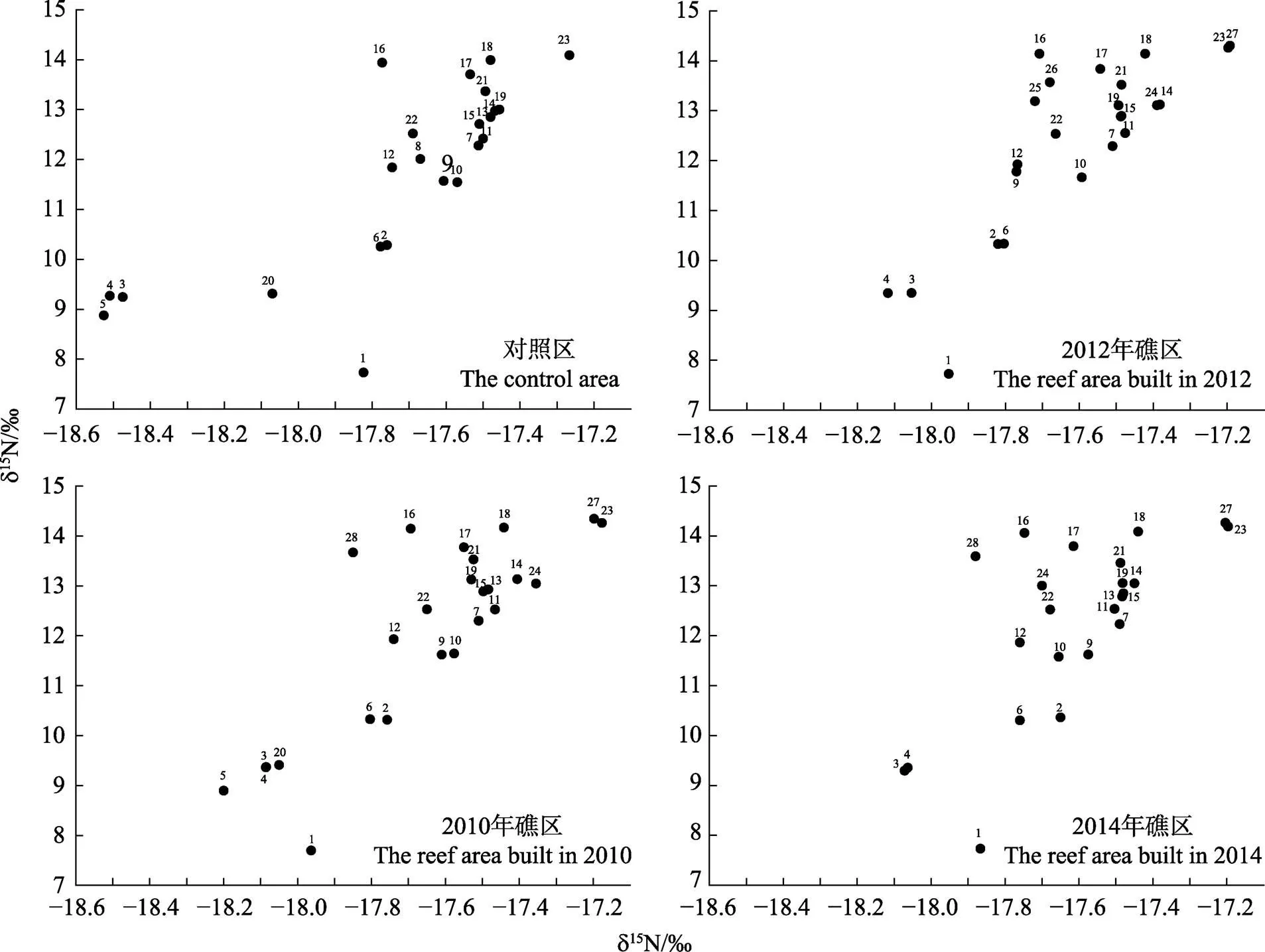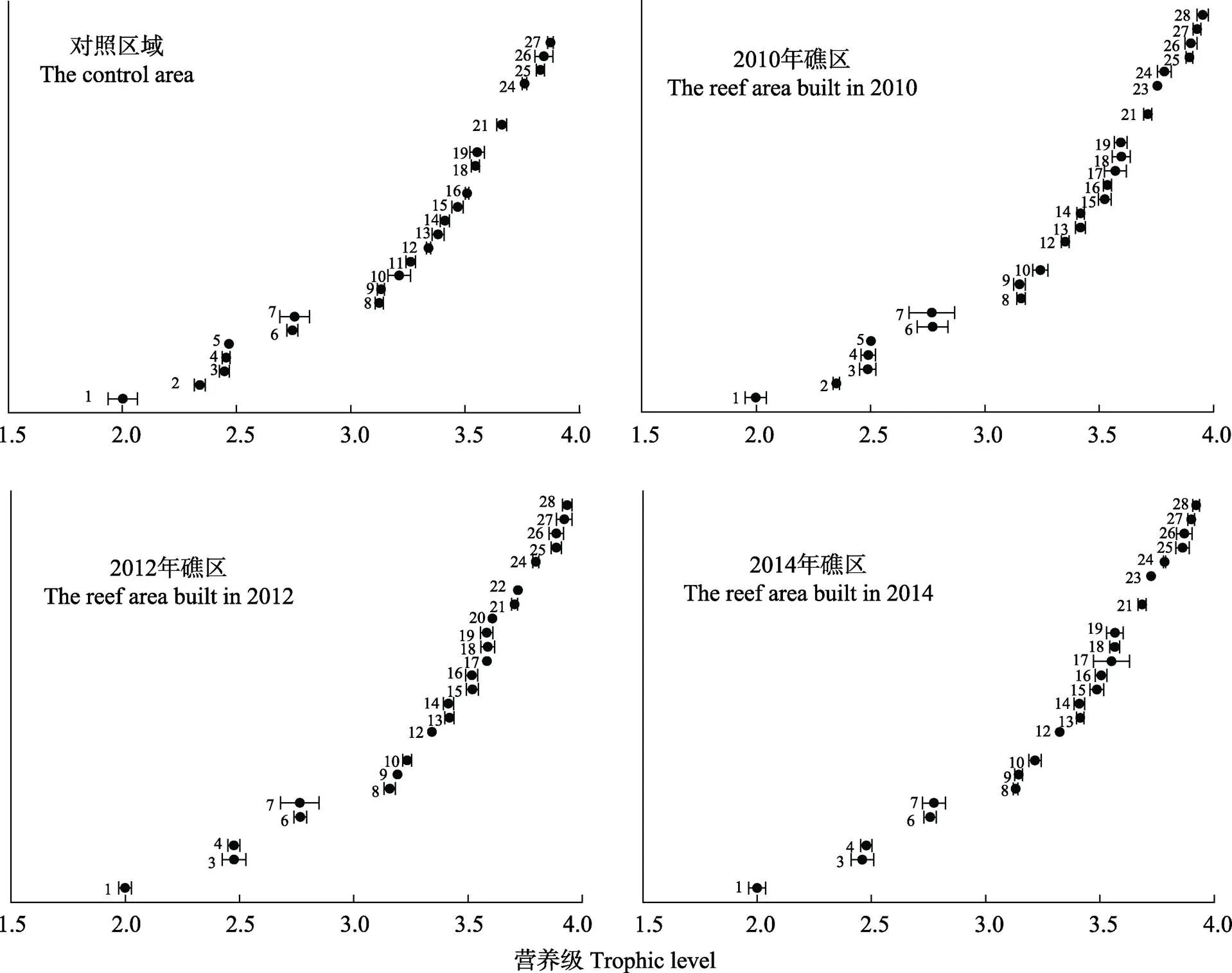基于稳定同位素技术的天津大神堂海域人工鱼礁区食物网结构研究*
张博伦 郭 彪 于 莹 徐晓甫 王 硕
基于稳定同位素技术的天津大神堂海域人工鱼礁区食物网结构研究*
张博伦1,2郭 彪1,2①于 莹1,2徐晓甫1,2王 硕1,2
(1. 天津渤海水产研究所渔业资源与生态环境室 天津 300457;2. 天津市海洋牧场技术工程中心 天津 300457)
本研究对2016年6月在天津大神堂3个礁区(2010年建成的鱼礁区;2012年建成的鱼礁区;2014年建成的鱼礁区)和对照区域采集的生物消费者及其食物源样品的碳、氮稳定同位素组成进行了分析,通过IsoSource模型计算不同区域生物的食物网基础,并利用氮稳定同位素数据计算消费者的营养级。结果显示,根据δ13C值可以将其食物源分为浮游植物、悬浮颗粒有机物(POM)和沉积相颗粒有机物(SOM)三类;浮游植物对消费者的碳源贡献率(67.2%~81.5%)最大,是大神堂海域的生物食物网的基础。不同区域同一食物源的δ13C和δ15N值没有显著性差异;礁区内滤食性贝类毛蚶()、菲律宾蛤仔()和长牡蛎()的δ13C值显著高于对照区,作为潜在碳源的浮游植物对其的贡献率显著增加。消费者的δ15N值则介于7.70‰~14.34‰之间,消费者的营养级介于2.0~3.95级之间。游泳生物食性生物的δ15N和营养级在礁区内有所提高,礁区建成的年份越长,其营养级与对照区域的差别越显著。稳定同位素研究表明,人工鱼礁建设可能导致鱼礁区内滤食性生物的食物来源组成改变,并提高游泳生物食性生物的营养级。
稳定同位素;人工渔礁区;食物网基础;营养级
稳定同位素技术是揭示食物网中物质的循环路径和探究消费者、生产者间营养关系的一种重要方法(Tomasz, 2015; Serguei, 2014; Vinagre, 2012),已经被广泛应用于水域生态系统食物网结构、营养关系及其动态变化的研究中(李忠义等, 2010; 魏虎进等, 2013; 麻秋云等, 2015; Serguei, 2014; Catarina, 2015)。与传统的胃含物分析法相比,稳定同位素反映了生物体对食物的吸收并且是生物体长时期代谢的结果,其不仅能表达生物体摄取的食物种类信息, 也表达了一段时间内生物体对食物的吸收信息(Kidd, 1995);因而突破了胃含物分析法研究生物摄食信息受时间和空间的限制(Kidd, 1995; 万祎等, 2005)。氮稳定同位素沿食物链基本上是逐级递增(李忠义等, 2010; 谭鲁玉等, 2018),所以氮稳定同位素用于计算生物的营养级,其正确性也得到了广泛验证(李忠义等, 2010; 魏虎进等, 2013; 麻秋云等, 2015)。由于碳稳定同位素随营养层次的富集不明显,其主要用于确定生物种的食物组成以及追踪生态系统中碳的来源(Fry, 1981; 李忠义等, 2005; 谢斌等, 2017)。
随着环渤海经济的快速发展、天津海岸带大规模的围填海工程建设、海洋捕捞业和矿产开采程度的增强,天津市第一个国家级海洋特别保护区——天津大神堂牡蛎礁国家级海洋特别保护区海洋生态系统受到的压力也逐年增加。为保护牡蛎礁区的生物资源和生态环境,天津市在大神堂海域开展了一系列海洋生态修复措施,人工鱼礁建设是其中重要的一项。在进行人工鱼礁建设过程中,了解食物网的营养基础和结构非常重要。目前关于天津市大神堂海域人工鱼礁区的报道主要集中在生物群落结构和重金属分布方面(郭彪等, 2015; 贾婷婷等, 2015; 戴媛媛等, 2016),未见食物网方面的报道。
因此,本研究利用稳定同位素技术对天津市大神堂海域人工鱼礁区食物网进行研究,探讨主要生物种类的碳氮稳定同位素特征,进而分析不同碳源对食物网的贡献和营养结构特征,旨在为深入研究天津大神堂海域生物群落的营养结构以及食物网的物质循环和能量流动提供基础资料,为从营养结构角度定量评价人工鱼礁的生态效果提供参考数据,为开展海洋生态修复与保护研究提供参考资料。
1 材料与方法
1.1 站位设置
2016年6月分别在2010年、2012年和2014年建成的人工鱼礁区各设置3个采样占位,另外礁区外围设置3个采样占位作为对照(图1)。在上述 12个点位进行浮游动植物、悬浮颗粒有机物(POM)、沉积相颗粒有机物(SOM)、底栖生物和游泳动物样品采集。

图1 采样占位设置
1.2 样品采集与处理
浮游植物使用浅水Ⅲ型浮游生物网进行从水底至水表垂直拖网采样;浮游动物采用浅水I型浮游生物网,从水底至水表垂直拖网采样;使用箱式采泥器采集SOM样品;利用箱式采泥器收集底栖大型无脊椎动物;游泳生物样品利用底拖网和地笼进行采集。
在实验室内,浮游植物样品用160 μm的筛绢进行过滤,除去浮游动物和碎屑等,经筛绢过滤后的浮游植物样品过滤到预先经马弗炉500℃灼烧5 h的Whatman GF/F膜上。底栖大型无脊椎生物和浮游动物置于预先经0.22 μm滤膜过滤的海水中暂养2~4 h,等排空胃含物后取样。采集表层水2 dm3,过170 μm的筛绢后过滤到预先经马弗炉500℃灼烧5 h的GF/F膜上收集POM样品。沉积物样品经过63 μm的筛绢分筛,所获得的颗粒物即为SOM样品。鱼类取适量背部白肌,虾取腹部肌肉,贝类取闭壳肌,蟹取其螯肢肌肉用于稳定同位素分析,所有样品使用冷冻干燥机于–50℃冻干;然后置于洁净的干燥器中用12 mol/dm3的盐酸(HCI)熏48 h,经石英研钵充分研磨后使用稳定同位素比值分析仪进行同位素分析。
1.3 稳定性同位素分析
实验样品的稳定同位素分析在天津国际医药联合研究院进行,运用英国GV公司的IsoPrime稳定同位素质谱仪测定样品的碳、氮稳定同位素比值。
碳、氮稳定同位素比值用国际通用的δ值表示,分别以VPDB (Vienna Pee Dee Belemnite) 国际标准和大气氮作为参考标准。δ13C、δ15N 分别按以下公式算出:

式中,13C/12CVPDB为国际标准物VPDB的碳同位素比值,15N/14Nair为标准大气氮同位素比值。为保持实验结果的准确性和仪器的稳定性,每测5个样品后加测1个标准样,个别样品则进行2~3次复测。
1.4 数据处理
利用IsoSource模型来计算各个食源对消费者的贡献率(Schwarcz, 1991),其原理是根据质量守恒原理:1种同位素及2种食物来源的能量守恒方程为:

式中,M为消费者M的1种同位素的比值;A、B为食物源;为食物对消费者的贡献率。
利用2种稳定同位素可对3种及3种以上食物的贡献比例进行计算:

式中,M、M为消费者M的2种同位素、的比值;A、B、C 为食物源;为食物对消费者的贡献率。本研究利用Phillips等(2003)利用质量守恒原理反复叠加编写的IsoSource模型来计算各食源对消费者的贡献率。
通过氮稳定同位素比值测定,分析天津海域非鱼礁区海洋生物营养级。其计算公式如下:


采用 Excel 2010和SPSS 19.0软件对数据进行统计分析,采用单因素(One-way ANOVA)进行方差分析或检验,利用Excel 2010和Grapher 5.0软件作图。图表中数据为平均值±标准差(Mean±SD)。
2 结果与分析
2.1 不同海域消费者潜在食源的δ13C、δ15N值
天津市大神堂海洋牧场不同年份礁区及对照区域潜在食源碳、氮同位素比值如表1和表2所示。经单因素方差检验,同一食源的δ13C、δ15N值在不同区域之间没有显著性差异,不同食源之间的碳、氮稳定同位素比值存在显著差异(<0.05)。
表1 消费者潜在碳源的δ13C值(‰)

Tab.1 Values of δ13 C for the potential carbon sources (‰)
注:同行不同字母表示3种潜在碳源之间的δ13C值差异显著(<0.05),下同
Note: Different letters in each row meant significant difference among the δ13C values of three potential carbon sources at 0.05 level. The same as below
表2 消费者潜在氮源的δ15N值(‰)

Tab.2 Values of δ15 N for the potential nitrogen sources (‰)
2.2 不同海域消费者的δ13C、δ15N值
天津市大神堂海洋牧场不同年份鱼礁区及对照区域消费者碳、氮同位素比值如图2所示。对照区域消费者的δ13C值分布从菲律宾蛤仔()的–18.53‰到中国花鲈()的–17.27‰;δ15N值分布从浮游动物的7.73‰到中国花鲈的14.12‰。2010年礁区海域消费者的δ13C值分布从长牡蛎()的–18.20‰到中国花鲈的–17.18‰;δ15N值分布从浮游动物的7.70‰到许氏平鲉()的14.34‰。2012年礁区海域消费者的δ13C值分布从菲律宾蛤仔的–18.12‰到许氏平鲉的–17.19‰;δ15N值分布从浮游动物的7.73‰到许氏平鲉的14.30‰。2014年礁区海域消费者的δ13C值分布从毛蚶()的–18.07‰到中国花鲈的–17.20‰;δ15N值分布从浮游动物的7.73‰到许氏平鲉的14.26‰。

图2 不同海域消费者的δ13C和δ15N值

1: Phytoplankton; 2:; 3:; 4:; 5:; 6:; 7:; 8:; 9:; 10:; 11:; 12:; 13:; 14:; 15:; 16:; 17:; 18:; 19:; 20:; 21:; 22:; 23:; 24:; 25:; 26:; 27:; 28:

表3 不同海域统计学δ13C值存在差异的物种(‰)1

Tab.3 Species with different values of δ13C from different areas (‰) 1
注:1:同行不同字母表示该物种在不同海域的δ13C值存在差异显著(<0.05);2:长牡蛎的数据不满足单因素方差分析条件,故进行检验
Note: 1: Different letters in each row meant significant difference amongthe δ13C values of the same species from different areas at 0.05 level; 2: Due to the values ofdoes not meet the condition of ANOVA analyze,-test was performed
表4 不同海域统计学δ15N值存在差异的物种(‰)

Tab.4 Species with different in values of δ15N from different areas (‰)
2.3 潜在碳源对不同海域消费者的贡献率

潜在碳源对不同海域大多数消费者的贡献率基本相似,但一些滤食性贝类(毛蚶、菲律宾蛤仔和长牡蛎)在不同海域有所差别。在对照区,浮游植物、SOM和POM对菲律宾蛤仔的碳源贡献率分别是67.2%、17.7%和15.1%;在不同年份的礁区,浮游植物、SOM和POM对菲律宾蛤仔的碳源贡献率相似,2010年礁区分别为75.2%、14.8%和10.0%,2012年礁区分别为75.0%、13.3%和11.7%,2014年礁区分别为75.9%、13.7%和10.4%。浮游植物对礁区内菲律宾蛤仔的碳源贡献率约是其在对照区的1.12倍,而SOM和POM的贡献率相应下降。毛蚶和长牡蛎在不同海域具有相似性规律。
表5 基于IsoSource混合模型计算出的潜在碳源对消费者的贡献率(%)

Tab.5 Results of the IsoSource model for consumers mean contributions of primary producers to consumer nutrition (%)
2.4 消费者的营养级
经计算,天津大神堂海域对照区、2010年礁区、2012年礁区和2014年礁区主要消费者生物种类的营养级范围分别在2.00~3.87、2.00~3.95、2.00~3.93和2.00~3.92;4个不同区域的营养层次均为三级(图3)。


图3 不同海域消费者营养级的分布

1: Phytoplankton; 2:; 3:; 4:; 5:; 6:; 7:; 8:; 9:; 10:; 11:; 12:; 13:; 14:; 15:; 16:; 17:; 18:; 19:; 20:; 21:; 22:; 23:; 24:; 25:; 26:; 27:; 28:
表6 不同海域统计学营养级存在差异的物种(‰)

Tab.6 Species with differences in trophic level from different area (‰)
注:同行不同字母表示该物种在不同海域的营养级存在差异显著(<0.05)
Note: Different letters in each row meant significant difference among the trophic levels of the same species from different areas at 0.05 level
3 讨论
驱动整个近岸水域生态系统运转的能量主要来源于初级生产者所提供的碳源,主要由POM、SOM、浮游植物和大型海藻组成(魏虎进等, 2013; 蔡德陵等, 2005)。天津海域大型海藻缺失,因此其碳源主要为POM、SOM和浮游植物。由于不同海区中POM和SOM的潜在源不同,其稳定同位素值可能有所差异。浮游植物的碳稳定同位素组成主要来自海洋水体中的溶解无机碳(DIC),δ13C值范围为–22‰~–18‰,并且存在着与温度和纬度的差异(吴莹等, 2002; 郭卫东等, 2001);典型的海源有机质(主要指浮游植物)的 δ15N值介于3‰~12‰之间(Maksymowska, 2002)。本研究中POM、SOM和浮游植物碳、氮稳定同位素值均符合上述研究中的数值范围,但与万祎等(2005)研究结果相比,数值偏高,这可能与采样时间不同有关(谢斌等, 2017; 吴莹等, 2002)。本研究中,POM、SOM和浮游植物碳、氮稳定同位素值在4个不同海域没有显著性差异。大神堂海域人工鱼礁区与对照区相比,浮游植物丰度明显增加,但种类组成变化不大(戴媛媛等, 2018);这佐证本研究中食物源的碳、氮稳定同位素值在礁区和非礁区没有显著性差异的结论。
毛蚶、菲律宾蛤仔和长牡蛎3种滤食性贝类,其主要食物为有机碎屑和浮游植物,虽然大神堂海域人工鱼礁区与对照区相比,浮游植物的种类组成变化不大,但浮游植物的丰度增加(戴媛媛等, 2018)。因此,礁区中这3种滤食性贝类其摄食的食物组成中,浮游植物量可能会相应增加。基于IsoSource模型计算的潜在碳源对消费者贡献率结果显示,浮游植物对礁区中毛蚶、菲律宾蛤仔和长牡蛎的贡献率显著高于对照区域。3种潜在碳源中,浮游植物的δ13C值最高,因而本研究中礁区内的毛蚶、菲律宾蛤仔和长牡蛎的δ13C值显著高于对照区域。这说明人工鱼礁的投放会导致滤食性贝类的食物组成发生变化,进而提高浮游植物对其的贡献率。


人工鱼礁的生态效益是在建成后逐步显现的(郭彪等, 2015; 吴忠鑫等, 2012),礁区生物营养级显著高于对照区域的生物种类数量,2014年礁区仅有3种,而较早投礁的2010年礁区则高达7种。在所有调查渔获的生物中,仅有短吻红舌鳎和许氏平鲉的营养级在不同年份礁区出现了差异,2010年礁区显著高于2014年礁区。一般情况下,鱼礁投放后鱼礁区鱼类和大型无脊椎动物群落结构会在1~5年内达到一个新的平衡(Bohnsack, 1985)。本研究中,同一种生物的营养级在不同礁区的差别,说明2012年和2014年礁区的生物群落结构尚未完全形成新的平衡,礁区的生态效应正在逐步显现。
总之,由于人工鱼礁区生物丰度增加,滤食性贝类的食物组成中,浮游植物的贡献率增加;肉食性、凶猛的生物捕获高营养级被捕食者的机率可能增加,从而导致其营养级有所提高。随着礁区建成年份的增加,礁区的生态效应逐步显现,礁区食物网中营养级相对较高的生物对这种改变响应较为明显。
Bohnsack JA, Sutherland DL. Artificial reef research: A review with recommendations for future priorities. Bulletin of Marine Science, 1985, 37(1): 11–39
Cai DL, Li HY, Tang QS,. The establishment of continuous nutrition spectra in the food web of the Yellow Sea and the East China Sea ecosystem: The results from stable isotope techniques. Science in China(C), 2005, 35(2): 123–130 [蔡德陵, 李红燕, 唐启升, 等. 黄东海生态系统食物网连续营养谱的建立:来自碳氮稳定同位素方法的结果. 中国科学C辑: 生命科学, 2005, 35(2): 123–130]
Catarina, Vanessa M, Luís N,. Food web of the intertidal rocky shore of the west Portuguese coast–determined by stable isotope analysis. Marine Environmental Research, 2015(110): 53–60
Dai YY, Wang H, Zhang BL,. Distribution of lead in multi-phase mediums of artificial reefs and potential ecological risk in summer. Journal Environment and Health, 2016, 33(4): 345–349 [戴媛媛, 王宏, 张博伦, 等. 夏季渤海湾人工鱼礁区多相介质铅的分布特征及其潜在生态风险. 环境与健康杂志, 2016, 33(4): 345–349]
Dai YY, Yang S, Hou CQ,. Relationships between the structure of phytoplankton community and environmental factor in artificial reefs of Tianjin coast. Transactions of Oceanology and Limnology, 2018(2): 60–66 [戴媛媛, 杨森, 侯纯强, 等. 礁区浮游植物群落结构特征及其与环境因子的关系. 海洋湖沼通报, 2018(2): 60–66]
Fabi G, Sala A. An assessment of biomass and diel activity of fish at an artificial reef (Adriatic Sea) using a stationary hydroacoustic technique. ICES Journal of Marine Science, 2002, 59(2): 411–420
Fry B. Natural stable carbon isotope tag traces Texas shrimp migrations. Fishery Bulletin United States, 1981, 79(2): 337– 345
Guo B, Yu Y, Zhang BL,. Changes of nekton community characteristics in artificial reef area, Dashentang, Tianjin. Marine Fisheries, 2015, 37(5): 409–418 [郭彪, 于莹, 张博伦, 等. 天津大神堂海域人工鱼礁区游泳动物群落特征变化. 海洋渔业, 2015, 37(5): 409–418]
Guo WD, Yang YP, Wu LX,. Stable carbon isotope study on trophic relationships of Zhubi reef ecosystem in Nansha Islands. Journal of Oceanography in Taiwan strait, 2001, 21(1): 94–101 [郭卫东, 杨逸萍, 吴林兴, 等. 南沙诸碧礁生态系营养关系的稳定碳同位素研究. 应用海洋学学报, 2002, 21(1): 94–101]
Jia TT, Gao Y, Hou CQ,. Distribution characteristics and ecological risk assessment of heavy metals in surface sediments around artificial reefs in offshore area of Bohai Bay. Journal Environment and Health, 2015, 32(12): 1092–1096 [贾婷婷, 高燕, 侯纯强, 等. 渤海湾近岸人工鱼礁区表层沉积物重金属分布特征及生态风险评价. 环境与健康杂志, 2015, 32(12): 1092–1096]
Kidd KA, Schindler DW, Hesslein RH,. Correlation between stable nitrogen isotope ratios and concentrations of organochlorines in biota from a freshwater food web.The Science of the Total Environment, 1995(160–161): 381–390
Li ZY, Jin XS, Zhuang ZM,. Applications of stable isotope techniques in aquatic ecological studies. Acta Ecologica Sinica, 2005, 25(11): 3052–3060 [李忠义, 金显仕, 庄志猛,等. 稳定同位素技术在水域生态系统研究中的应用. 生态学报, 2005, 25(11): 3052–3060]
Li ZY, Zuo T, Dai FQ,. Trophic level analysis of organisms from Changjiang estuary and adjacent waters of southern Yellow Sea in spring with stable isotope technology. Journal of Fishery Sciences of China, 2010, 17(1): 103–109 [李忠义, 左涛, 戴芳群, 等. 运用稳定同位素技术研究长江口及南黄海水域春季拖网渔获物的营养级. 中国水产科学, 2010, 17(1): 103–109]
Maksymowska D, Richard P, Piekarek-Jankowska H,. Chemical and isotopic composition of the organic matter sources in the Gulf of Gdansk (Southern Baltic Sea). Estuarine Coastal and Shelf Science, 2008, 51(5): 585–598
Ma QY, Han DY, Liu H,. Construction of a continuous trophic spectrum for the food web in jiaozhou bay using stable isotope analyses. Acta Ecologica Sinica, 2015, 35(21): 7207–7218 [麻秋云, 韩东燕, 刘贺, 等. 应用稳定同位素技术构建胶州湾食物网的连续营养谱. 生态学报, 2015, 35(21): 7207–7218]
Minagawa M, Wada E. Stepwise enrichment of15N along food chains: Further evidence and the relation between δ15N and animal age. Geochimica et Cosmochimica Acta, 1984, 48(5): 1135–1140
Phillip DL, Gregg JW. Source partitioning using stable isotopes: Coping with too many sources. Oecologia (Berlin), 2003, 136 (2): 261–269
Schwarcz HP. Some theoretical aspects of isotope paleodiet studies. Journal of Archaeological Science, 1991(18): 261– 275
Serguei IK, Vladimir IK, Karen S,. Trophic structure of the abyssal benthic community in the Sea of Japan inferred from stable isotope and fatty acid analyses. Marine Ecology Progress Series, 2014(500): 121–137
Tan LY, Wang YK, Tang XX,. Distribution characteristics of the stable nitrogen isotope in different tissues of small yellow croaker and the ecological significance in the Yellow Sea. Progress in Fishery Sciences, 2018, 39(3): 30–35 [谭鲁玉, 王玉堃, 唐学玺, 等. 黄海小黄鱼不同组织中δ15N的分布特征及其生态学意义. 渔业科学进展, 2018, 39(3): 30–35]
Tomasz M, Niedźwiecki M, Małgorzata A,. Stable isotope analyses revealed high seasonal dynamics in the food web structure of a peatbog. International Review of Hydrobiology, 2015, 100(5-6): 141–150
Vinagre C, Máguas C, Cabral HN,. Food web structure of the coastal area adjacent to the Tagus estuary revealed by stable isotope analysis. Journal of Sea Research, 2012, 67(1): 21–26
Wan W, Hu JY, An LH,. Study on the trophic levels of the main species in Bohai bay food networ by using stable nitrogen and carbon isotope. Chinese Science Bulletin, 2005, 50(7): 708–712 [万祎, 胡建英, 安立会, 等. 利用稳定氮和碳同位素分析渤海湾食物网主要生物种的营养层次. 科学通报, 2005, 50(7): 708–712]
Wang ZH, Zhang SY, Wang K. Fish and macroinvertebrates community structure in artificial habitat around Sanheng Isle, Shengsi, China. Acta Ecologica Sinica, 2010, 30(8): 2026–2035 [汪振华, 章守宇, 王凯. 三横山鱼礁生境鱼类和大型无脊柱动物群落特征. 生态学报, 2010, 30(8): 2026–2035]
Wei HJ, Zhu XM, Ji YN,. Study on the food web structure and their trophic levels of marine ranching area in Xiangshan Harbor. Journal of Applied Ocean0graphy, 2013, 32(2): 250–257 [魏虎进, 朱小明, 纪雅宁, 等. 基于稳定同位素技术的象山港海洋牧场区食物网基础与营养级的研究.应用海洋学学报, 2013, 32(2): 250–257]
Wu Y, Zhang J, Zhang ZF,. Seasonal variability of stable carbon and nitrogen isotope of suspended particulate matter in the Changjiang river. Oceanologia et Limnologia Sinica, 2002, 33(5): 546–552 [吴莹, 张经, 张再峰, 等. 长江悬浮颗粒物中稳定碳、氮同位素的季节分布. 海洋与湖沼, 2002, 33(5): 546–552]
Wu ZX, Zhang L, Zhang XM,. Nekton community structure and its relationship with main environmental variables in Lidao artificial reef zones of Rongcheng. Acta Ecologica Sinica, 2012, 32(21): 6737–6746 [吴忠鑫, 张磊, 张秀梅, 等. 荣成俚岛人工鱼礁区游泳动物群落特征及其与主要环境因子的关系. 生态学报, 2012, 32(21): 6737–6746]
Xie B, Li YK, Zhang H,. Food web foundation and seasonal variation of trophic structure based on the stable isotopic technique in the marine ranching of Haizhou Bay, China. Chinese Journal of Applied Ecology, 2017, 28(7): 2292– 2298 [谢斌, 李云凯, 张虎, 等. 基于稳定同位素技术的海州湾海洋牧场食物网基础及营养结构的季节性变化. 应用生态学报, 2017, 28(7): 2292–2298]
Study of the Food-Web Structure in the Dashentang Artificial Reef Area in Tianjin Using a Stable Isotope Technique
ZHANG Bolun1,2, GUO Biao1,2①, YU Ying1,2, XU Xiaofu1,2, WANG Shuo1,2
(1. Department of Fisheries Resources and Ecologic Environment, Tianjin Bohai Sea Fisheries Research Institute, Tianjin 300457;2. Center for Marine Ranching Engineering Science Research of Tianjin, Tianjin 300457)
The present study aimed to quantitatively evaluate the ecological effects of artificial reefs from the perspective of the food-web structure and provide reference material for marine ecological restoration and conservation research. A stable isotope technique was applied to analyze consumers and their potential carbon sources. Samples were collected from the reef areas built in 2010, 2012, and 2014 and the control area in Dashentang during June 2016. An IsoSource model was used to construct the food web. Stable isotopes were used to calculate the trophic levels of the consumers. The results showed that food sources can be categorized into three categories based on the δ13C values of phytoplankton, particulate organic matter, and soil organic matter. Phytoplankton represented the largest source of carbon for consumers (67.2%~81.5%). The findings from the IsoSource mix model revealed that phytoplankton were the main contributors to the food web in the studied areas. There were no significant differences in the δ13C or δ15N values of the same food sources from different areas. The δ13C values of suspension- feeding bivalves, including,, and, were significantly higher in the reef areas than in the control area. The proportion of phytoplankton in the carbon sources for suspension-feeding bivalves was significantly higher in the reef areas than in the control area. The δ15N values of consumer species ranged from 7.70‰ to 14.34‰, and the trophic levels ranged from 2.0 to 3.95. The δ15N values or trophic levels of piscivorous consumers were higher in the reef areas than in the control area, and the level of significance increased with the duration of the reefs. The findings indicate that artificial reefs might induce an abundance of organisms in reef areas, leading to changes in the composition of the food sources of suspension-feeding bivalves and an increase in the trophic levels of piscivorous consumers.
Stable isotope; Artificial reef area; Food web; Trophic level
S931
A
2095-9869(2019)06-0025-11
10.19663/j.issn2095-9869.20180912001
http://www.yykxjz.cn/
张博伦, 郭彪, 于莹, 徐晓甫, 王硕. 基于稳定同位素技术的天津大神堂海域人工鱼礁区食物网结构研究. 渔业科学进展, 2019, 40(6): 25–35
Zhang BL, Guo B, Yu Y, Xu XF, Wang S. Study of the food-web structure in the Dashentang artificial reef area in Tianjin Using a stable isotope technique. Progress in Fishery Sciences, 2019, 40(6): 25–35
* 天津市水产局青年科技创新项目(J2016-10青)、天津市农业科技成果转化与推广项目(201304150)和天津市渔业发展服务中心青年科技创新项目(J2018-14青)共同资助[The work was supported by Projects of Youth Science and Technology Innovation of Tianjin Aquatic Products Bureau (J2016-10Qing), Tianjin Agricultural Science and Technology Achievement Transformation and Promotion Project(201304150), Projects of Youth Science and Technology Innovation of Tianjin Fishery Development Service Center (J2018-14Qing)]. 张博伦,E-mail: hello5521@163.com
郭 彪,高级工程师,E-mail: oucguobiao@163.com
2018-09-12,
2018-10-19
GUO Biao, E-mail: oucguobiao@163.com
(编辑 江润林)

